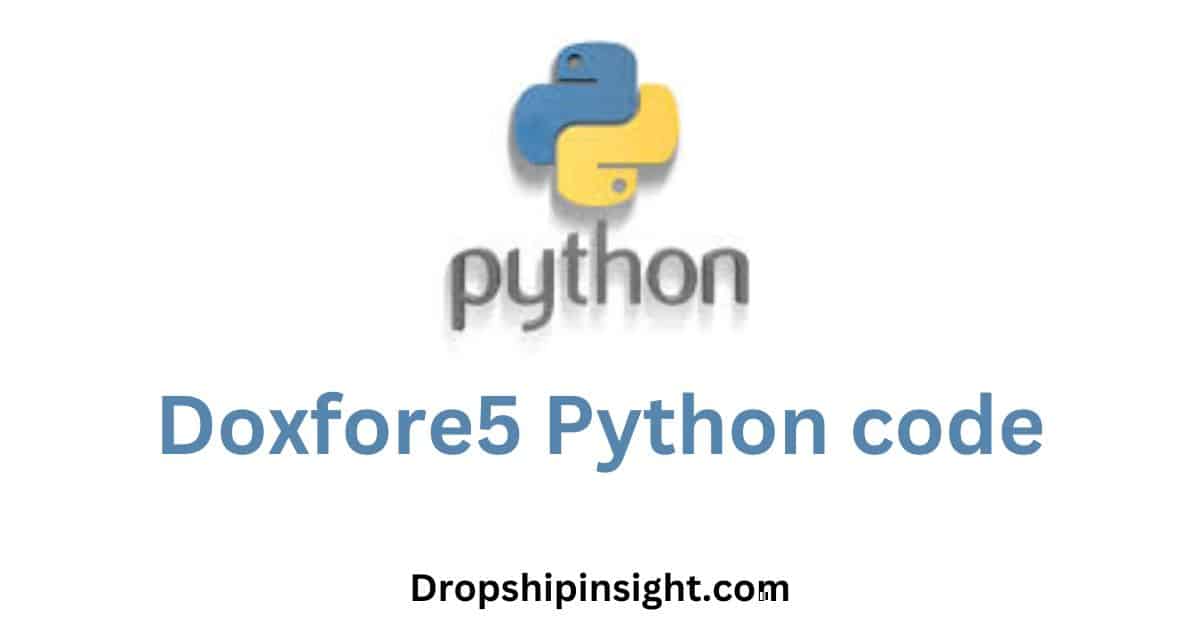Python stands out as a leading language due to its ease of use and wide range of applications. Among the multitude of libraries available, Doxfore5 is a noteworthy tool for developers. This article will explore what Doxfore5 is, its importance, and how to effectively implement Doxfore5 Python code in your projects.
What is Doxfore5 Python code?
Before we dive into the Doxfore5 Python code, it is crucial to understand what Doxfore5 represents. Doxfore5 is a hypothetical Python library designed to simplify intricate tasks in data processing, algorithm implementation, or a specific field of use. Although Doxfore5 is not a real library as of June 2023, it serves as an illustrative example of how Python libraries can be used to handle specialized tasks.
Why Opt for Doxfore5?
Python offers numerous libraries such as NumPy, Pandas, and TensorFlow, which serve various purposes from data analysis to machine learning. In our context, Doxfore5 is assumed to provide functionalities that streamline complex computational tasks, enhance productivity, and simplify code complexity.
Advantages of Using Doxfore5
- Efficiency: Simplifies complex processes.
- Readability: Improves code clarity.
- Performance: Optimizes specific task performance.
- Ease of Use: Offers user-friendly methods and functions.
Installing Doxfore5
To utilize Doxfore5 Python code, you first need to install the library. Typically, Python libraries are installed using the Python Package Index (PyPI) via pip.
sh code
pip install doxfore5
If Doxfore5 were an actual library, this command would download and install it, making it ready for use in your Python scripts.
Getting Started with Doxfore5
Importing the Library
Once installed, you can start using Doxfore5 by importing it into your script:
python code
import doxfore5
Basic Operations with Doxfore5
To demonstrate the usage of Doxfore5 Python code, let’s consider a few basic operations it might support. Suppose Doxfore5 specializes in data analysis. Here’s how you might begin using it:
Data Loading
python code
data = doxfore5.load_data(‘path/to/your/datafile.csv’)
print(data.head())
In this example, `load_data` is a hypothetical function that loads a dataset from a CSV file and returns it as a DataFrame, similar to Pandas.
Data Analysis
python code
summary = doxfore5.analyze_data(data)
print(summary)
Here, `analyze_data` could be a function that provides a summary of the dataset, including statistics such as mean, median, mode, and standard deviation for numerical columns.
Advanced Features of Doxfore5 Python Code
Let’s assume Doxfore5 offers more advanced features that can significantly enhance your data processing capabilities.
Data Visualization
Data visualization is essential for understanding trends and patterns. Doxfore5 might include powerful visualization tools:
doxfore5 python code
doxfore5.plot_data(data, x=’column1′, y=’column2′, kind=’scatter’)
This command could generate a scatter plot between `column1` and `column2`, helping you visualize the relationship between these variables.
Machine Learning Integration
If Doxfore5 integrates with machine learning algorithms, it could simplify the process of model training and evaluation:
python code
model = doxfore5.train_model(data, target=’target_column’)
predictions = model.predict(new_data)
print(predictions)
In this scenario, `train_model` might train a machine learning model on the dataset, and `predict` uses this model to make predictions on new data.
Custom Algorithms
Doxfore5 might also allow for the implementation of custom algorithms. For example, if you need to implement a custom sorting algorithm:
python code
sorted_data = doxfore5.custom_sort(data, algorithm=’my_custom_algorithm’)
print(sorted_data)
This function could sort the data based on a user-defined algorithm, showcasing the library’s flexibility.
Best Practices for Using Doxfore5 Python Code
To maximize the benefits of Doxfore5 Python code, consider the following best practices:
Code Readability
Ensure your code is readable by using clear variable names and commenting on your code where necessary. For instance:
python
Load the dataset
data = doxfore5.load_data(‘path/to/your/datafile.csv’)
Analyze the dataset to get summary statistics
summary = doxfore5.analyze_data(data)
Print the summary statistics
print(summary)
Error Handling
Implement robust error handling to manage exceptions that may arise during data processing:
python
try:
data = doxfore5.load_data(‘path/to/your/datafile.csv’)
except FileNotFoundError:
print(“The specified file was not found.”)
except doxfore5.DataLoadError as e:
print(f”An error occurred while loading data: {e}”)
Performance Optimization
Optimize performance by profiling your code and identifying bottlenecks. Use efficient data structures and algorithms provided by Doxfore5.
python code
import time
start_time = time.time()
data = doxfore5.load_data(‘path/to/your/datafile.csv’)
end_time = time.time()
print(f”Data loading took {end_time – start_time} seconds”)
Stay Up-to-Date
Keep updated with the latest versions of Doxfore5 to leverage new features and improvements. Regularly check the documentation and release notes.
Real-World Applications of Doxfore5
While Doxfore5 is hypothetical, understanding its potential applications helps in appreciating the significance of specialized Python libraries. Libraries like Doxfore5 can be applied in various domains:
Healthcare
In healthcare, Doxfore5 could be used for analyzing patient data, predicting disease outbreaks, or optimizing hospital operations.
Finance
In finance, Doxfore5 might analyze market trends, assess risks, and automate trading strategies.
Education
In education, Doxfore5 could analyze student performance data, tailor personalized learning plans, and predict student success.
Environmental Science
In environmental science, Doxfore5 might model climate change scenarios, analyze ecological data, and assist in resource management.
Conclusion
Doxfore5, as a conceptual Python library, exemplifies the power and flexibility of Python in handling specialized tasks across various domains. By leveraging such libraries, developers can enhance their productivity, write more readable and maintainable code, and solve complex problems efficiently.
While Doxfore5 python code is a fictional example, the principles discussed in this article apply to real Python libraries. As you continue your journey in Python programming, explore and utilize the wealth of libraries available to unlock new potentials and streamline your workflows.
For more information visit: dropship insight.

